This year marks the centenary of the birth of one of the most important composers of contemporary music, Iannis Xenakis. This composer and civil engineer of Greek descent was born in 1922 in Romania, educated in Greece and died in 2001 in Paris. He had a very intense personal life that was not without emotions, as he was part of the Communist Resistance in World War II and also participated in the first phase of the Greek civil war. During World War II he received a severe shell wound to the left side of his face that almost killed him, causing him to lose an eye and disfiguring part of his face. Despite this, he managed to complete his studies and graduate as an engineer. He was always persecuted for his political activism. Tired of this situation, he ended up settling permanently in Paris, where he met Le Corbusier. The fascination between the two was instantaneous. Xenakis immediately joined his studio as a calculating engineer. They worked together from 1948 until 1960, when their professional relationship ended with the commission for the Philips Pavilion, their best-known joint work.

Iannis Xenakis and Le Corbusier.
Both understood architecture and music as parallel arts in reasoning, creation and freedom: …to make music or architecture is to create, to engender environments that envelop sonorously or visually, poems… That brought them closer. I don’t know the reason for their break-up, but I can imagine it: if you remember my previous articles about Le Corbusier, those close to him said that as a boss he was dreadful, unpredictable and arrogant. I suppose it only took one project for that mutual admiration to disappear and their professional relationship to take a different direction.

Iannis Xenakis and Le Corbusier in the latter’s studio.
When contemplating a work of architecture we recognise the union of geometry, order and proportion. Something similar happens when listening to a piece of music: if we read a score, we see that the staves define the order and proportion over which the notes slide, composing sound spaces and, why not, visual spaces as well. There are scores of great visual beauty.

The convent of Saint Marie de la Tourette in Eveux-sur-l’Arbresle (Lyon). Le Corbusier.
But this is not new. If we go back in history we see that Pythagoras had already experimented with these concepts in his Theory of Harmony or the Spheres:
The universe is governed according to harmonious numerical proportions and that the motion of the heavenly bodies according to the geocentric representation of the universe – the Sun, the Moon and the planets – is governed according to musical proportions; the distances between planets would, according to this theory, correspond to musical intervals.
It is not difficult to see that, yes, there is a relationship between geometry, architecture and music, and that to some extent harmony and order govern the cosmos.

Philips Pavilion, Brussels Universal Exhibition 1958. Work by Le Corbusier and Iannis Xenakis. © Photo Wikimedia commons/wonter hagens.
This idea of bringing order to chaos in order to turn it into an ordered element was a theme that obsessed Le Corbusier as much as it did Xenakis. For them art, and music in particular, was a system capable of organising sensations. But this idea of proportion and measure as the basis for the structuring of art, and by analogy of the world, was neither Le Corbusier’s nor Xenakis’ invention. It had already been used since the Renaissance by Palladio, Alberti and other architects, but it is true that it was they, Le Corbusier and Xenakis, who consciously used the series of proportions existing in music to compose the structure of their buildings.

The convent of Saint Marie de la Tourette in Eveux-sur-l’Arbresle (Lyon). Le Corbusier.
All this reasoning resulted in the creation of the Modulor, a fundamental concept for understanding both Le Corbusier’s and Xenakis’ work. The Modulor is a measuring tool derived from human stature and mathematics. A system of measurements on a human scale created by Le Corbusier based on the golden ratio. A man with his arm raised gives the determining points of the occupation of space – the foot, the solar plexus, the head, the fingertips with the arm raised – three intervals that define a series of Fibonacci’s golden sections; and, on the other hand, Mathematics offers a value: the single, the double and the two golden sections.
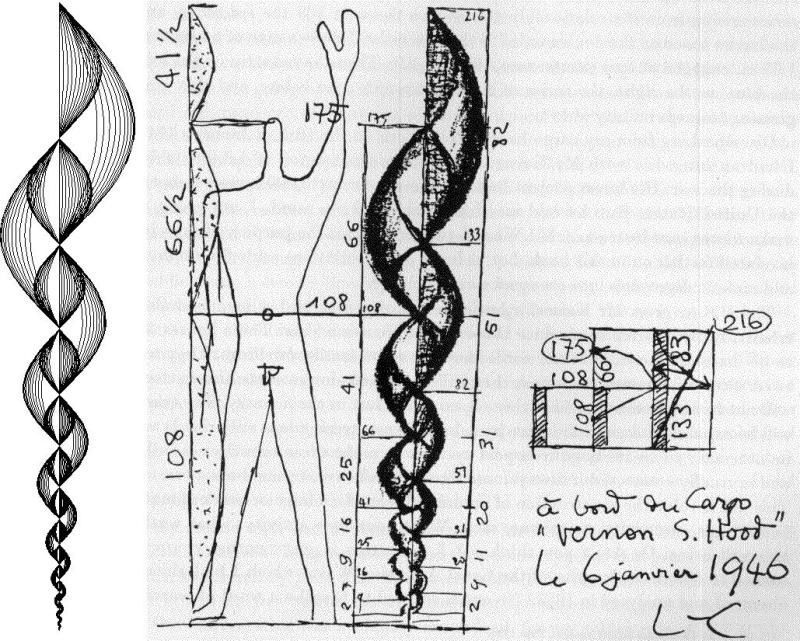
Drawing of The Modulor, Le Corbusier.
Although it is a constructive concept, Le Corbusier’s philosophy, the search for architectural order, can be seen in it, as it implied a definition of perfect and beautiful measurements with the idea of an architecture conceived as a microcosm based on mathematics. Thus a home created with Modulor dimensions was to provide the inhabitant with a sense of well-being, comfort and harmony.
Music is time and space, like architecture. Music and architecture depend on measurement.
This set of harmonic measures had a musical equivalence, which may have inspired their work, not only during the twelve years they worked together, but also later on. Thus, music and architecture emerge as organisations of sound intervals or metrical elements in time and space.
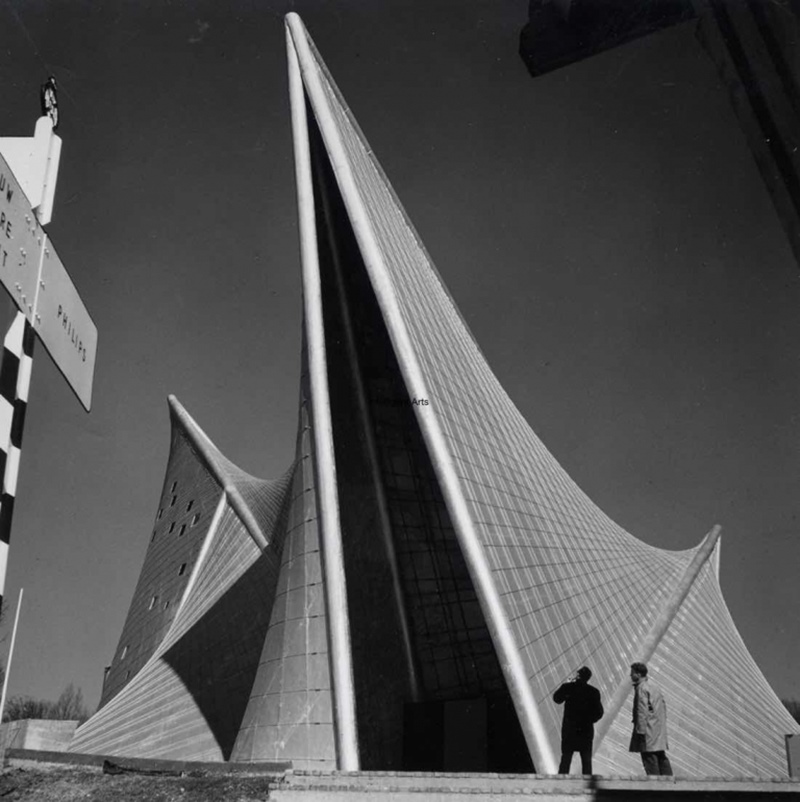
Philips Pavilion, Brussels Universal Exhibition 1958. Designed by Le Corbusier and Iannis Xenakis.
However, Xenakis, a restless and curious character, went a step further. His obsession with the relationship between architecture and music led him to speculate not only on the concepts of space, proportion and abstraction that connect them, but also on others such as symmetry, masses and space-time. For him, abstraction was an aesthetic concept that could be observed in all human activities and which parallels the birth of modern algebra (around 1910). In music, it would correspond to the time of the discovery of tonality based on the equivalence of the twelve sounds.
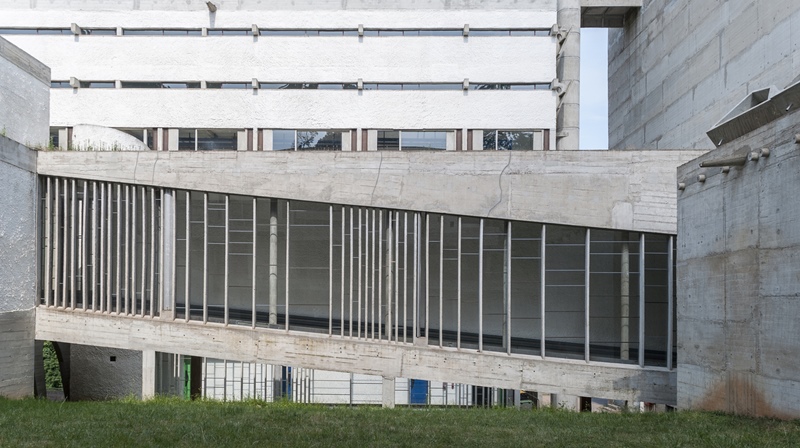
The convent of Saint Marie de la Tourette in Eveux-sur-l’Arbresle (Lyon). Le Corbusier.© Photo Fernando Schapochnik.
For Xenakis the concept of space is directly linked to music. He uses all his knowledge of Euclidean space from architecture/engineering and music to create a musical space. A single sound space that becomes a complete universe in which to generate an aesthetic stimulus for each sense. But for this to work, we cannot forget about rhythm, which is responsible for finding certain points on the timeline, in the same way that in architecture, points are marked on the plane along straight lines. We can also contemplate architecture in the piano keys arranged in a constant way.

The convent of Saint Marie de la Tourette in Eveux-sur-l’Arbresle (Lyon). Le Corbusier. © Photo Fernando Schapochnik.
With this in mind, it is not difficult to imagine that Xenakis and Le Corbusier designed the Philips Pavilion together, since that project was intended to bring together and link architecture and music. Le Corbusier did not want to build a building but an electronic poem, and so he approached Xenakis, who was eager to experiment and link these two disciplines. His idea was to generate curved surfaces from straight lines, inspired by his recent musical composition Metastasis, premiered in 1955.
The Philips Pavilion was an ephemeral construction for the 1958 Brussels World’s Fair. The project was commissioned by the Dutch company Philips. The company’s artistic director, M. Louis Kalff, wanted a space that would house a modern multimedia show in which the company’s own products would be highlighted by sound effects, lighting and the latest technological advances.

Philips Pavilion, Brussels Universal Exhibition 1958. Designed by Le Corbusier and Iannis Xenakis.
The pavilion is a true visual poem. An asymmetrical composition made up of 9 hyperbolic paraboloids, each of which was in turn made up of straight pieces of prefabricated concrete approximately 1.5 m wide and 6 cm thick, and which were supported by tensioning cables on both sides. These outer steel tensors were exposed, revealing a reticulated surface, a marvellous three-dimensional pentagram on which the music glided. The interior walls of the pavilion were covered with asbestos to create a cavernous effect and enhance the acoustic sensation. Engineer Hoyte Duyster was on hand to help them carry out the complex project on a technical level.
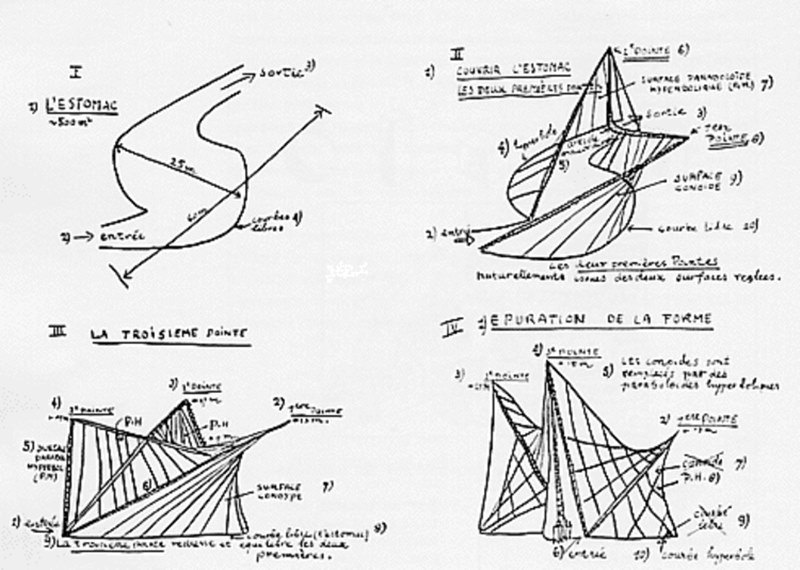
Sketches of the Philips Pavilion by Le Corbusier and Iannis Xenakis.
The building achieved notoriety because of its radical approach and because it was the first construction to reflect the intense artistic fusion of architecture, image and sound. But I suppose that for two such obsessive people, with such clear ideas both architecturally and musically, it would cause them some professional friction and they decided to end their professional relationship.
From that moment on, Xenakis always tried to ensure that physics, architecture and mathematics interacted in his later compositions. Examples of this are his works: Polytopes, Diatope, East-West and Diamorphosis.

The convent of Saint Marie de la Tourette in Eveux-sur-l’Arbresle (Lyon). Le Corbusier. © Photo Fernando Schapochnik.
On his part, Le Corbusier focused his professional career on architecture, becoming one of the great exponents of modern architecture. Even so, he did not forget the stage he shared with Xenakis, an example of which is the Convent of Saint Marie de la Tourette in Eveux-sur-l’Arbresle (Lyon), also known as The Convent of Xenakis. It is a building whose façade was a progression of rectangles of different widths, placed in rows and with changing densities and intervals to give an asymmetrical appearance. In it, the abstract elements were the straight line and its repetition, the rhythmic oscillation between verticality and horizontality, as in Greek temples. He used the proportions of the Modulor to design a combined system of windows to create a sequence of musical rhythms of glass in honour of Xenakis.
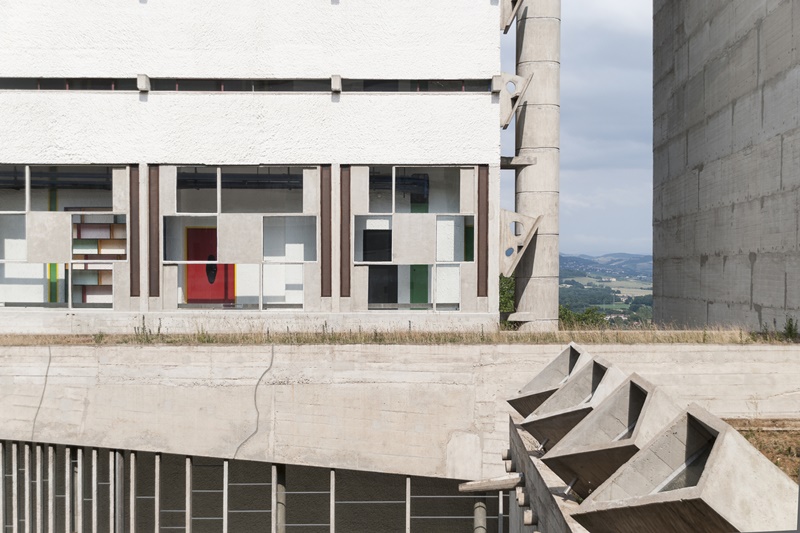
The convent of Saint Marie de la Tourette in Eveux-sur-l’Arbresle (Lyon). Le Corbusier. © Photo Fernando Schapochnik.
For his part, Xenakis focused more on music and continued to experiment until 1966, when he founded a Centre for Mathematics/Music Studies (CEMAMU) in Paris, where he designed the UPIC (CEMAMU’s Polylogical Information Unit), a device in which any line could be drawn on a screen, and the machine would transform it into music.

Iannis Xenakis y el UPIC (Unidad Poliagógica del Información del CEMAMU).
Xenakis’ music is admired and imitated, because through it he manifested his sense of freedom and non-conformism. His dissident attitude and his intense participation in resistance movements directly influenced the music of artists of the “alternative” experimental scene. Just as the work of Le Corbusier marked a before and after in the world of architecture.









No one has posted any comments yet. Be the first person!